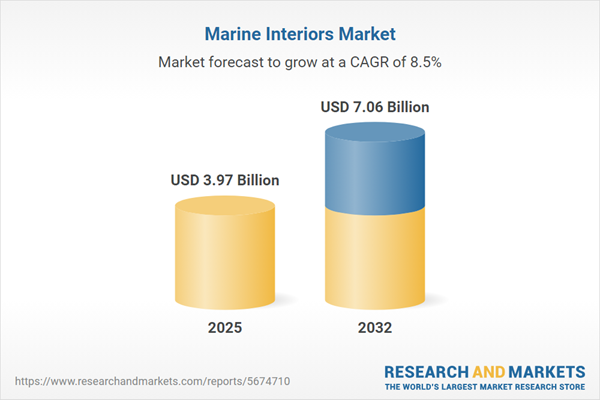Speak directly to the analyst to clarify any post sales queries you may have.
The marine interiors market is experiencing measurable transformation as vessel operators and suppliers respond to stringent regulatory demands, shifting passenger expectations, and heightened sustainability objectives. To guide capital planning and operational strategy, senior decision-makers need granular market and technology insight.
Market Snapshot: Marine Interiors Market Outlook and Growth
The global marine interiors market reached USD 3.66 billion in 2024, projected to increase to USD 3.97 billion by 2025. Continuing on a trajectory with a CAGR of 8.54% through 2032, the market is anticipated to surpass USD 7.06 billion.
This growth is driven by sustained investment in advanced materials and modernization of vessel interiors. Leading operators are implementing innovative composites and digital work processes to achieve environmental compliance, improve operational efficiency, and enhance competitive positioning. Modernization cycles prioritize long-term value for both ship owners and supply chain participants as compliance, workflow integration, and aesthetic goals evolve.Scope & Segmentation of the Marine Interiors Market
- Vessel Types: Market solutions target commercial ships, cruise liners, ferries, naval vessels, and yachts. Each segment demands tailored interiors to balance guest experience, safety, and operational performance, while accommodating diverse use profiles and branding.
- Product Types: Interior offerings include bathroom fittings, modular furniture, specialized upholstery, engineered seating, integrated lighting, decorative wall panels, and storage components. Suppliers enable functional layouts and effective space branding across vessel classes.
- Application Areas: Solutions span galleys, lounges, washrooms, crew quarters, suites, corridors, and public zones, maintaining uniform safety and visual standards in every onboard space.
- Distribution Channels: The market engages OEMs, aftermarket service providers, and refurbishment specialists, supporting agile procurement as vessel design trends and regulations shift.
- Material Types: Providers embrace carbon fiber composites, fiberglass, advanced metals, specialty glass, engineered wood, and durable synthetics. Material selection underpins longevity, operational efficiency, and compliance with evolving standards.
- Installation Modes: Both custom-fit and modular installations support efficient project delivery, from new builds to retrofits, by streamlining timelines and budget management.
- Geographic Coverage: The market spans the Americas, Europe, Middle East & Africa, and Asia-Pacific. Regulatory requirements and supply strategies drive differing demand patterns and technology adoption in each region.
- Leading Companies Analyzed: Detailed analysis covers Fincantieri S.p.A., Meyer Werft GmbH, Chantiers de l’Atlantique S.A., Hyundai Heavy Industries, STX Offshore & Shipbuilding, Mitsubishi Heavy Industries, Damen Shipyards Group, Lürssen GmbH, Azimut-Benetti S.p.A., and Oceanco B.V., focusing on technical capabilities and alignment with market evolution.
Key Takeaways for Marine Interiors Decision-Makers
- Adoption of versatile interior layouts strengthens daily operations, increases process efficiency, and reinforces passenger satisfaction.
- Using resilient, sustainable materials helps organizations address compliance requirements and reduce maintenance needs across asset lifecycles.
- Digital platforms, such as CAD and virtual reality, are now integral for design accuracy and closer collaboration among architecture and engineering teams.
- Routine upgrades and refurbishments remain vital for maintaining both safety standards and the overall onboard experience for all stakeholders.
- Efficient partnerships throughout the technology supply chain provide the agility necessary to respond to regulatory modifications and operational profile changes.
- Continuous risk mitigation regarding sourcing and compliance helps preserve uninterrupted service in tightly regulated marine operations.
Tariff Impact: 2025 US Tariffs and the Marine Interiors Supply Chain
The introduction of new US tariffs in 2025 is increasing complexity across marine interiors procurement and manufacturing. Suppliers are broadening sourcing channels, prioritizing domestic material acquisition, and expanding regional production of composite and metal elements to counteract tariff exposure. Maintaining operational flexibility and proactive risk management is essential in the face of evolving regulatory landscapes.
Methodology & Data Sources
This analysis draws on robust secondary research, structured expert interviews, and established sector-specific methodologies. Collaboration with industry specialists and standards organizations aligns findings with contemporary marine interiors best practices, ensuring actionable guidance for strategic use.
Why This Report Matters: Strategic Marine Interiors Market Insights for Leadership
- Comprehensive segmentation analysis and competitor mapping assist leaders in navigating procurement challenges and identifying strategic investment opportunities as the market progresses.
- Continuous monitoring of sector innovation, supply trends, and regulatory effects enables agile responses by B2B operators to emerging risks and opportunities.
- Practical recommendations help senior teams mitigate supply and compliance risks to sustain organizational resilience and drive business continuity.
Conclusion
Decision-makers who invest in up-to-date market intelligence and flexible supply strategies can more effectively manage the evolving complexities of the marine interiors sector. This report equips leaders with the clarity needed to address present and future market shifts.
Additional Product Information:
- Purchase of this report includes 1 year online access with quarterly updates.
- This report can be updated on request. Please contact our Customer Experience team using the Ask a Question widget on our website.
Table of Contents
3. Executive Summary
4. Market Overview
7. Cumulative Impact of Artificial Intelligence 2025
Companies Mentioned
The companies profiled in this Marine Interiors market report include:- Fincantieri S.p.A.
- Meyer Werft GmbH
- Chantiers de l'Atlantique S.A.
- Hyundai Heavy Industries Co., Ltd.
- STX Offshore & Shipbuilding Co., Ltd.
- Mitsubishi Heavy Industries, Ltd.
- Damen Shipyards Group
- Lürssen GmbH
- Azimut-Benetti S.p.A.
- Oceanco B.V.
Table Information
| Report Attribute | Details |
|---|---|
| No. of Pages | 198 |
| Published | November 2025 |
| Forecast Period | 2025 - 2032 |
| Estimated Market Value ( USD | $ 3.97 Billion |
| Forecasted Market Value ( USD | $ 7.06 Billion |
| Compound Annual Growth Rate | 8.5% |
| Regions Covered | Global |
| No. of Companies Mentioned | 11 |









